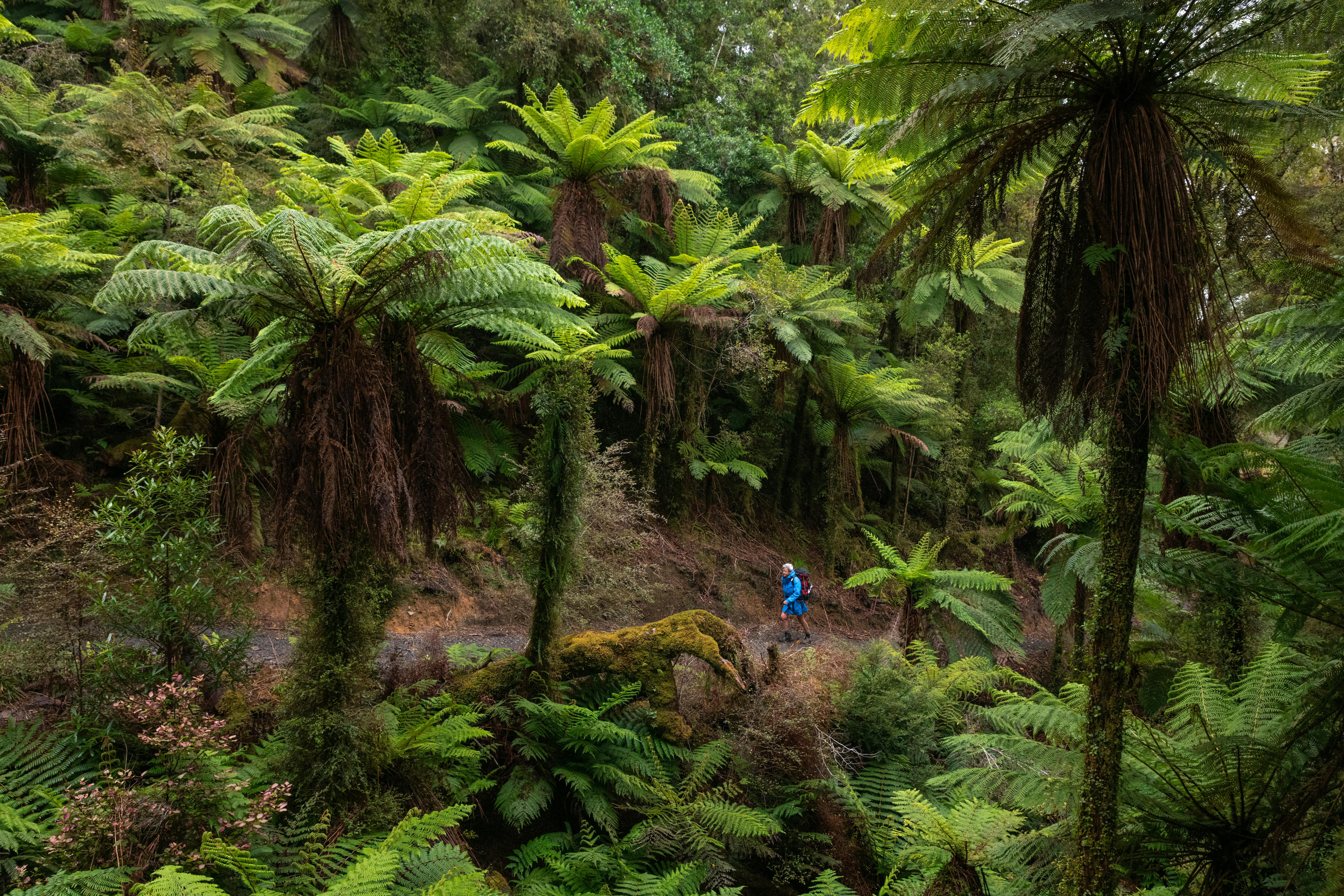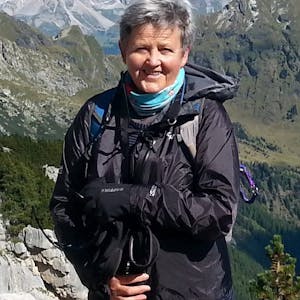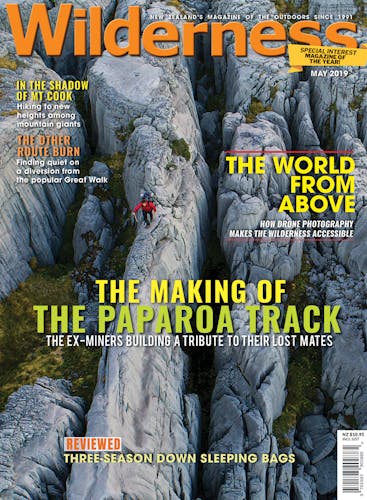Excitement and pride is building with the progress made on the Paparoa Great Walk. Kathy Ombler explored the nearly-finished Pororari Valley section of the 65km track
The rainfall of no name
A hanging garden of ferns and roots and air shows a fallen master once stood here,
With beech of red and silver, Nothofagus is the genus; podocarps aplenty and rata in its splendour,
And it seems Dr Seuss has been here with his truffula trees; Dracphyllum is the Latin name for these.
With Fehi and Gita trying to do their best, ‘twas the rainfall of no name that made the most mess.
– Barry Gordon, track builder
Track builder, digger driver, explosives expert, stoat trapper, former miner, staunch West Coaster and sometime poet, Barry Gordon, turned to verse to express what he saw when a succession of storms ravaged the rainforest of Paparoa’s Pororari Valley in early 2018 and played havoc with the building timetable of the Paparoa Great Walk.
Gordon works for WestReef, the Westport company contracted to build roughly a third of the new track, and which also helped build the Old Ghost Road. He’s been working in the valley since 2017, based now in the new Pororari Hut as the team forges uphill towards the tops.
The Great Walk is being fashioned by three specialist track-building teams; WestReef (Pororari Valley to Paparoa Range), Nelson-based Nelmac (Pike29 Memorial Track and main range to Moonlight Tops Hut) and DOC (Moonlight Tops). All are following environmental standards set by DOC, and the route designed by mountain bike trail specialist, Hamish Seaton.
When the three crews meet up they’ll have created New Zealand’s newest and only purpose-built dual walking/mountain biking Great Walk track, encompassing an impressive mix of karst limestone grandeur, rainforest and rock and tussock tops, plus mining heritage and a Pike River Mine memorial. From the work already done, it’s obvious these guys are all about professionalism, pride in their work, and sheer hard yakka. They’ve also faced off against everything the weather could possibly throw at them.
Sitting by the fire in the big but cosy Pororari Hut, swirling mist outside hiding what he says is a stunning view, Gordon was trying to explain the power of that weather. Last year they faced not only two ex-tropical cyclones that shattered swathes of the forest, but an un-named rain event between them that flooded their mid-valley camp, tossed aside heavy digger and crusher machinery, demolished three wooden bridges (now replaced) and raised Watson Creek oh-so-close to a new, very high, swingbridge.
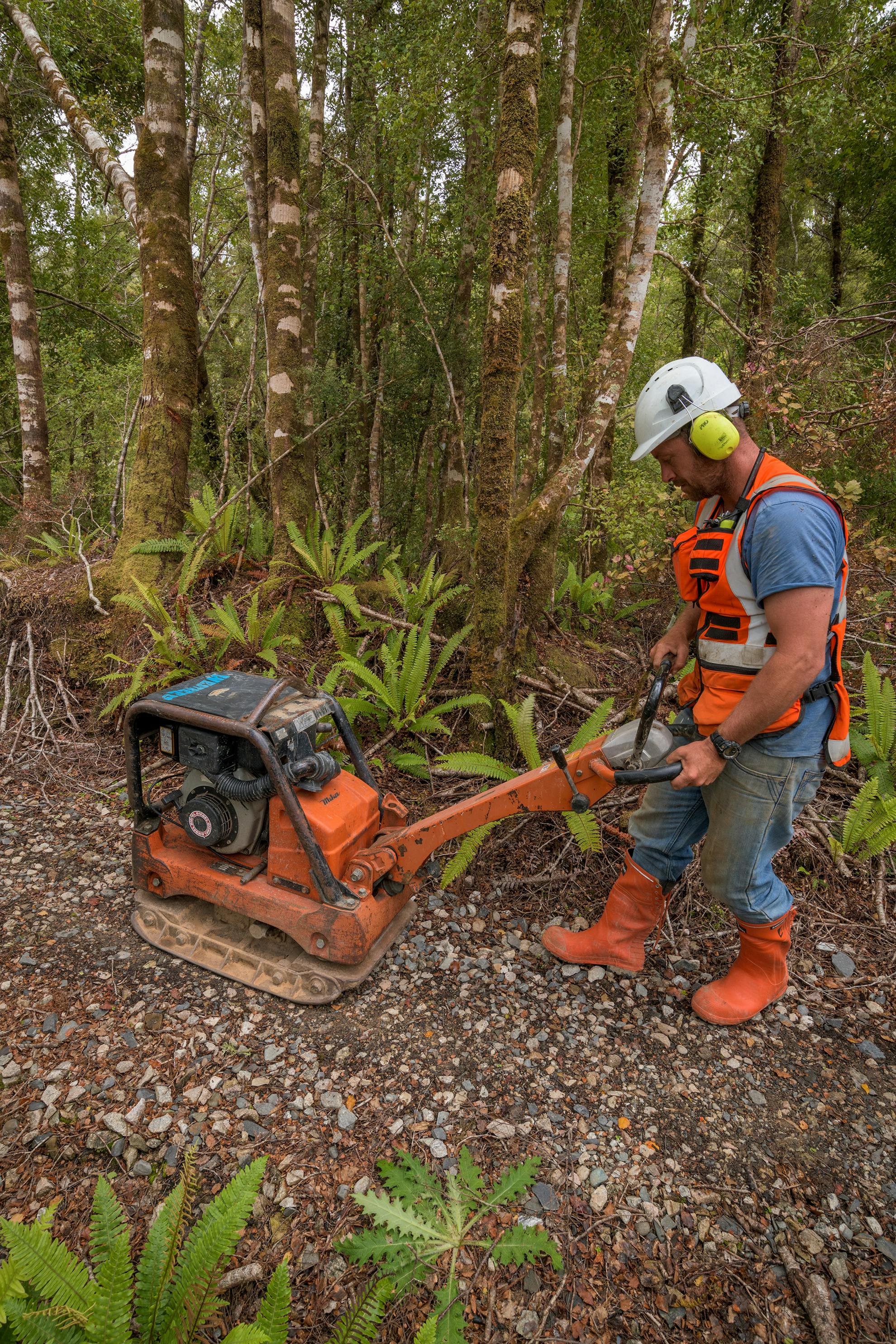
“There were lightning strikes and sheets and sheets of rain, I’ve never seen anything like it,” he says, reaching for his notebook of scribbled poems to better explain.
Poetry aside, it’s yoga that relaxes colleague Nigel Williams after a long day hewing mountain rock and wind-blown trees. Gordon describes Williams, who was away during our visit, as a genius with both the digger and the chainsaw. He says a third teammate, Jye Hawes, busy washing dinner dishes while we chatted, brings skills from a building and construction background.
“We’re all former miners, foresters or builders,” Gordon says. “With the extraction industries dying out on the Coast, the skills we have are a perfect fit for track construction. Whether we’re blasting rock and working with diggers in opencast mines or on a new track, the same principles are used.”
Diggers, crushers, blasting, chainsaws. With such talk one might expect the new track to be an ugly metal wound, bleeding through beautiful West Coast bush that will take years to recover. I know I did. But here’s the cool thing, the new track looks like it’s always been there.
It wends its mossy, fern-lined way gently up the valley, through tangled rainforest and tree fern-shaded tomo shafts. The tannin-coloured Pororari River burbling below.
“A huge amount of work goes into remediation,” says DOC’s project director, Tom Hopkins. “When they strip the organic layer from the track surface, the small ferns and mosses, that’s all put aside and when the track’s done it’s replanted on the sides and the cuttings and corners. It settles down really quickly.”
Remediation goes beyond replanting, says Gordon. “When we put culverts under the track we line the edges with rocks so you can’t see that the culverts are there. We also use the local rock – limestone where it’s limestone and granite further up the valley. Tracks in other parks have flown rock in and it doesn’t look right.”
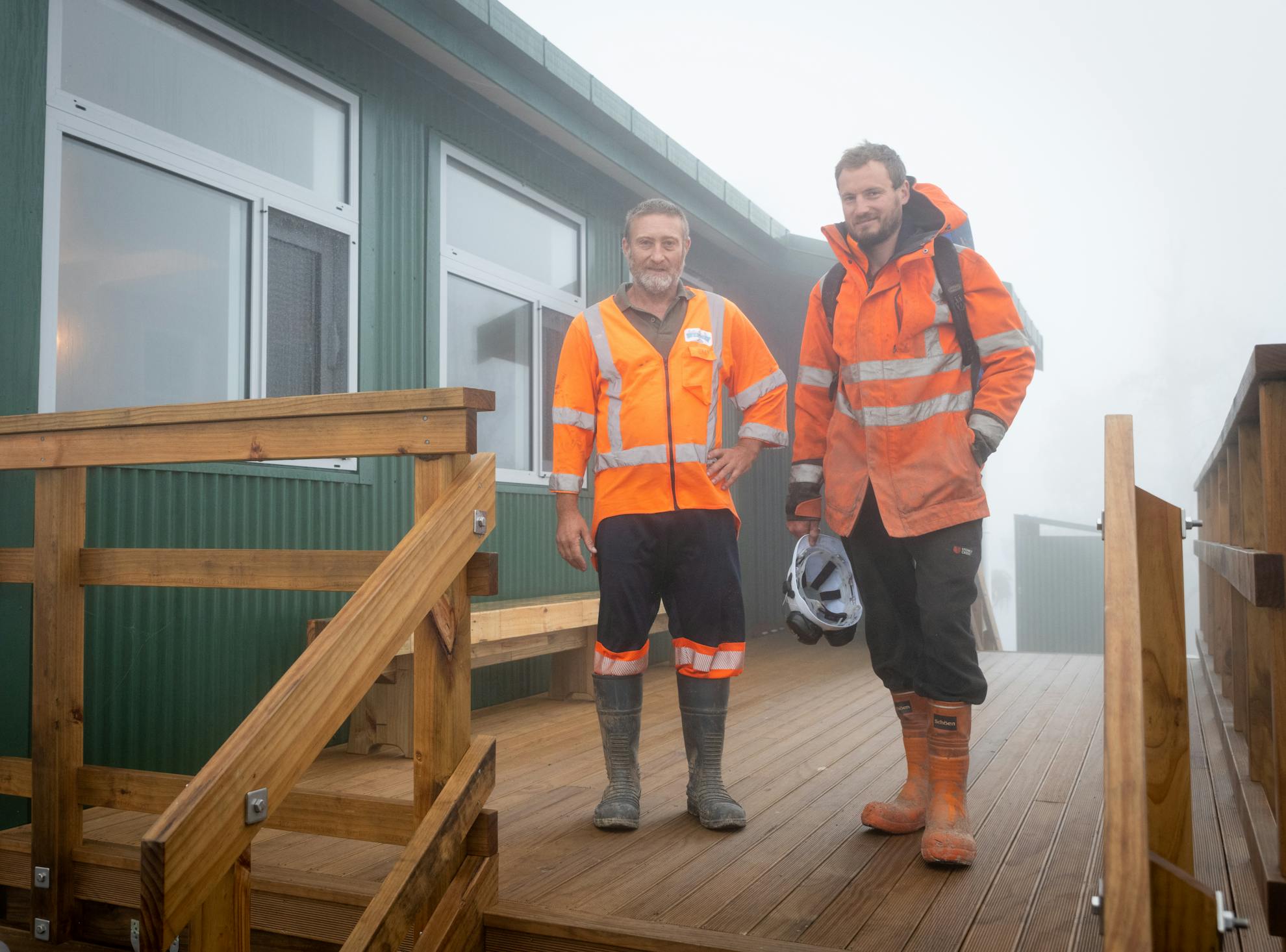
They also consider carefully before felling any tree and avoid doing so if possible, adds Hopkins. “If they have to fell it, they’ll cut it into small pieces and distribute it through the forest so it’s not seen and will decompose quicker.”
Nature, when it comes to tree felling, has not been so discerning. Gordon says the views from Pororari Hut are courtesy of winds that tore out surrounding trees. In the valley, snapped and splintered boles of beech, totara and rata are a reminder of the fury of last year’s Fehi and Gita storms. However, it was Cyclone Ita, in 2014, that really blasted the lower valley, leaving a chaos of massive trees strewn about like matchsticks. Happily, the fallen giants have provided the perfect source for corduroy, the timber flitches so useful on boggy sections of track.
At first glance, I thought these tidy lengths had been machine-milled and flown in. Wrong. The corduroy is the work of ‘genius’ Williams, who cut metre-long lengths from the wind-blown trees then trimmed them with machine-like precision, all by chainsaw. With matting underneath and crushed rock compacted on top, the track will last for years, says Gordon.
Given the propensity for heavy rain, water management is a major factor in track design, he adds, before expounding a technical explanation of how ‘swales’ are constructed to ensure maximum drainage. I didn’t fully understand, but he sounded confident.
Walking out, we met WestReef ‘crusher guru’ Dwayne Ingham, manoeuvring a heavy, vibrating machine that compacts crushed rocks on the track surface. It seemed like a lonely, noisy, shuddering existence but Ingham says he loves working on his own, with no-one to hassle him.
Some walkers bemoan the hard surface of a built-for-bikes track, but I found Dwayne’s crushing and compacting had worked a treat. We walked the 16km in, then out the next day, and even my tender feet were fine. And apart from one small zigzag, there were no long, graded switchback tracks that are found on some bike tracks. At least not that we saw.
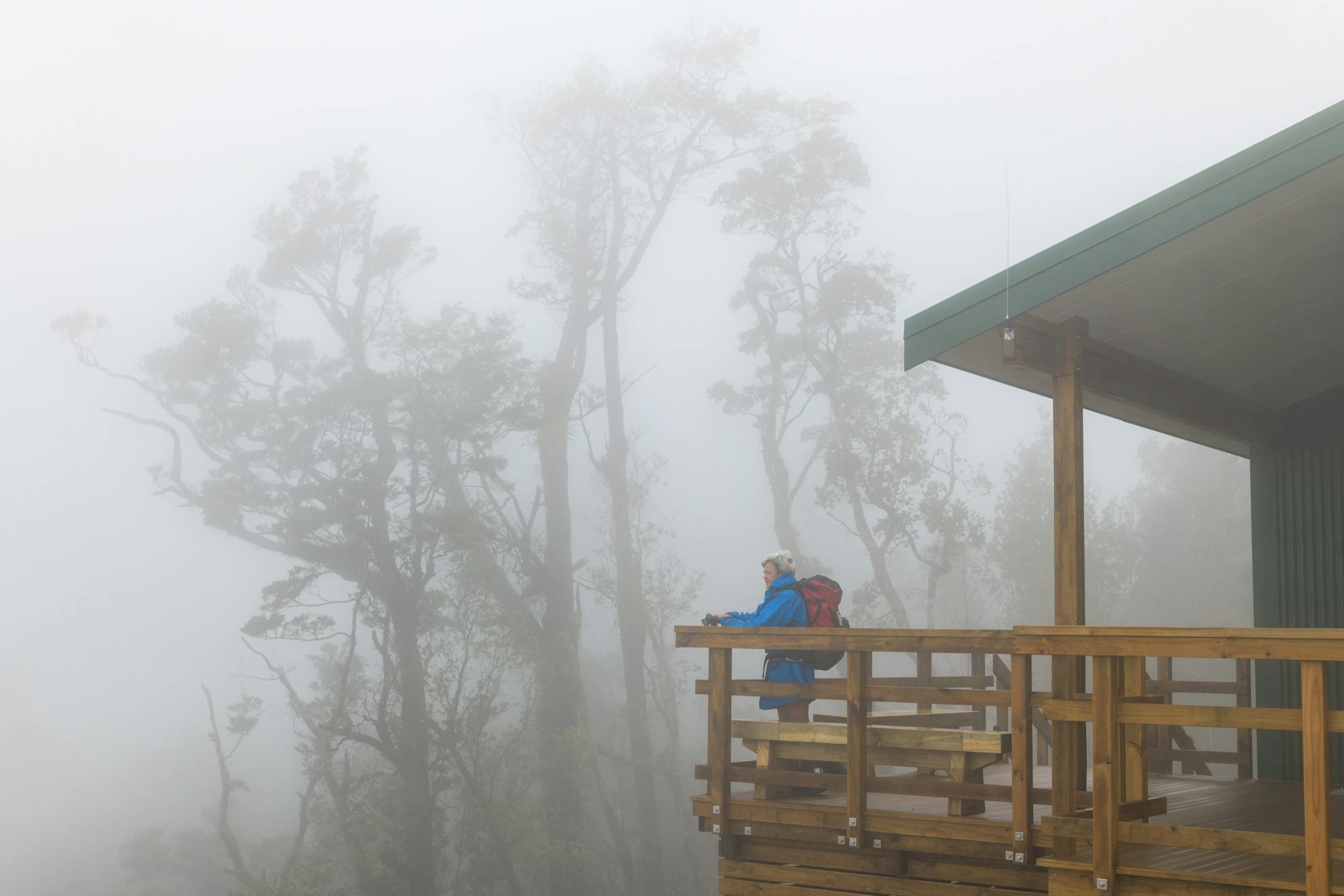
Hopkins doesn’t see an issue in the dual track use. “The minimum standards for a Great Walk track and Grade Four mountain bike track are almost identical. The only major difference is a gradient requirement for biking. A walking track could go steeper, however, that might not provide the best user experience for our target walking group. I think that the gradient of this track, and the way Hamish has designed it to make best use of the climbing, has worked out well. It’s certainly easier to walk a bike-friendly track than the other way round.”
He knows that sharing a track with mountain bikers won’t suit some walkers. “However, based on the response on the Heaphy Track, Taupo’s Great Lake Trail and the increasing number of trampers using the Old Ghost Road, we are confident the two groups can cohabit, as long as they show respect towards each other.”
Back at the hut, the track builders are relishing their time in the valley. The team works seven days on, seven days off and was due to fly out the day we were there but such was the weather, that didn’t happen. They weren’t fazed and planned to use the time to check the trap lines WestReef has established in the valley.
The birdlife, Hawes chips in, is amazing. “When we first came in, possums were everywhere, we were trapping them and they just kept coming. Then DOC spread 1080. Two or three months after the drop, the possums had gone and the birdlife is getting better and better. I just love it.
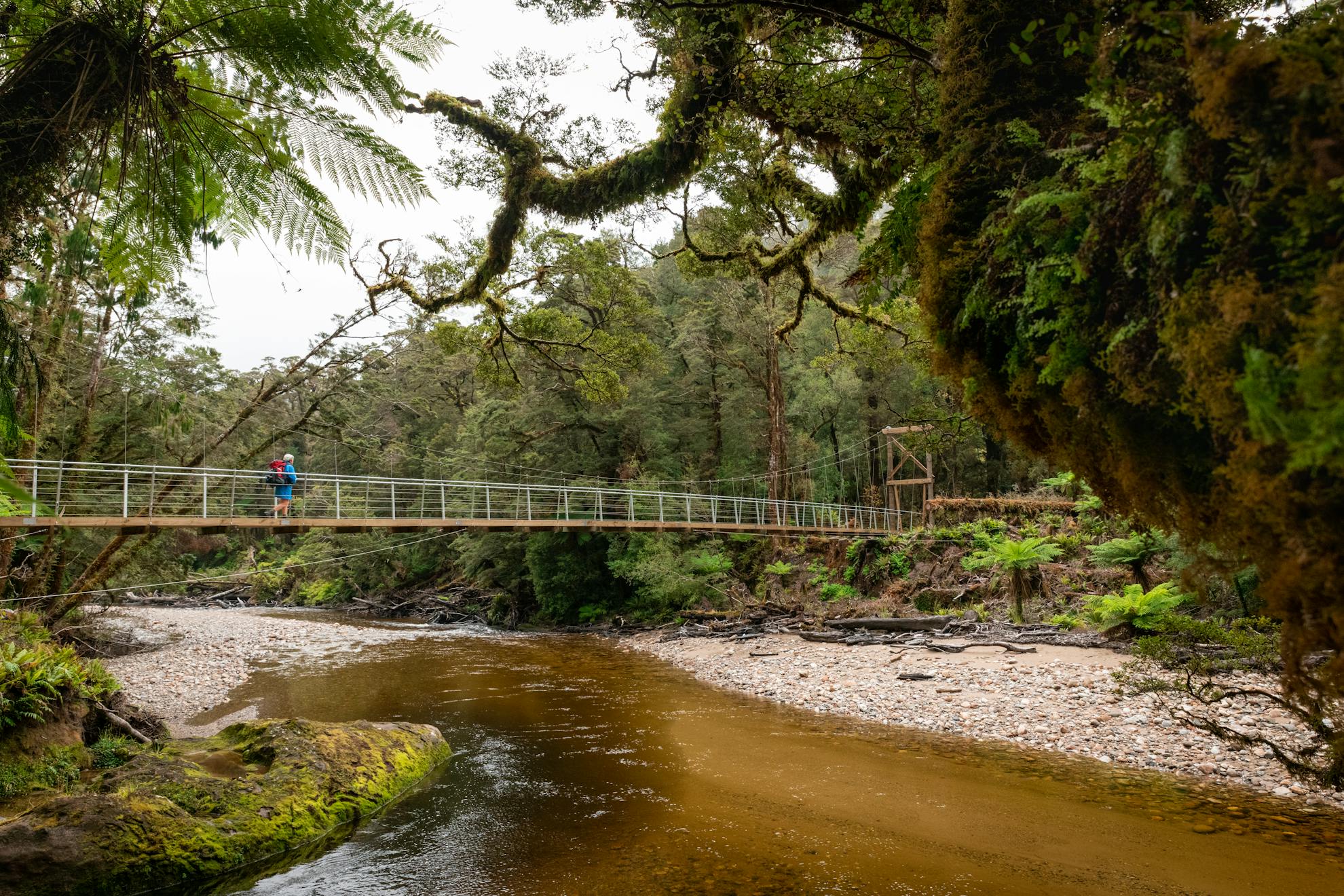
“We’ve got robin, tomtit, rifleman, parakeet, kākā, falcon, weka, and long-tailed and shining cuckoo in summer. We heard roroa (great spotted kiwi) when we were camped at Watson Creek. The kea up here are incredible, they’re hard on our gear though,” he laughs.
Gordon says he used to be against 1080. He’s changed his mind. “Being in here, I’ve seen with my own eyes the difference it’s made to the birds and the bush. I saw some white rata flowering this season, it’s just beautiful,” he adds.
Sometimes, Gordon says he has to shake himself to think this is where he works. “I’m so lucky. When you live in an area like this and do the work you love to do, well it doesn’t feel like it’s work.”
He’s also looking forward to sharing it all. “It’s going to be great for the Coast. Whether you’re a biker or a walker, we’ve got the Heaphy, the Old Ghost Road and soon this track to bring more people to see what beautiful country we have here.”
The WestReef crew is now building the track above the hut. Gordon says the terrain is more challenging but spectacular, with “all the rocky ridges, big old totara and amazing shapes of rata”.
There’s something else he feels good about: being up high. “I used to work in mines. I was in Pike River for a while and I’ve got mates still in there. It feels good to be up here, close to them. Where we’re working now is the closest, they’re just through there, it’s nice to be here with them.”
And so, a key purpose of the new Great Walk, to remember those lost in the Pike River Mine, is clearly, already, being achieved.
First in a quarter of a century
The 55km Paparoa Track and 10km Pike 29 Memorial Track combined will be the first new Great Walk in 25 years, and the first purposely-built for both mountain bikers and walkers. Its development has a dual purpose: to bring economic benefit to a region torn by the demise of traditional extraction industries and to remember the 29 miners lost in the Pike River Mine.
The track crosses Paparoa National Park from near Punakaiki to near Blackball. It heads up the Pororari Valley onto the southern Paparoa Range (bikers will enter via the Inland Pack Track). It passes The Escarpment limestone feature, travels the Moonlight Tops and descends via the Croesus Track, a gently-graded miner’s trail. Pike29 Memorial Track climbs from the Pike River Mine site to join the Paparoa Track on the Paparoa Range. There are two new Great Walk huts; Pororari and Moonlight Tops.
The Great Walk is due to open in December 2019 and the Pike29 Memorial Track will open once the mine re-entry project is completed.





